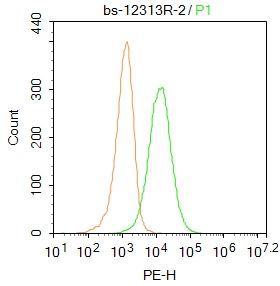产品货号 : mlR12313
英文名称 : PHEX
中文名称 : 维生素D低磷性佝偻病蛋白
别 名 : HPDR; HPDR1; HYP; HYP1; LXHR; Metalloendopeptidase homolog PEX; PEX; Phex; PHEX_HUMAN; Phosphate regulating endopeptidase homolog X linked; Phosphate regulating gene with homologies to endopeptidases on the X chromosome; Phosphate-regulating neutral endopeptidase; Vitamin D-resistant hypophosphatemic rickets protein; X-linked hypophosphatemia protein; XLH.
研究领域 : 发育生物学 干细胞
抗体来源 : Rabbit
克隆类型 : Polyclonal
交叉反应 : Human, Mouse, Rat, Dog, Pig, Cow, Horse, Rabbit, Sheep,
产品应用 : ELISA=1:500-1000 IHC-P=1:400-800 IHC-F=1:400-800 Flow-Cyt=1ug/Test ICC=1:100-500 IF=1:100-500 (石蜡切片需做抗原修复)
not yet tested in other applications.
optimal dilutions/concentrations should be determined by the end user.
分 子 量 : 86kDa
细胞定位 : 细胞膜
性 状 : Lyophilized or Liquid
浓 度 : 1mg/ml
免 疫 原 : KLH conjugated synthetic peptide derived from Human PHEX:201-300/749
亚 型 : IgG
纯化方法 : affinity purified by Protein A
储 存 液 : 0.01M TBS(pH7.4) with 1% BSA, 0.03% Proclin300 and 50% Glycerol.
保存条件 : Store at -20 °C for one year. Avoid repeated freeze/thaw cycles. The lyophilized antibody is stable at room temperature for at least one month and for greater than a year when kept at -20°C. When reconstituted in sterile pH 7.4 0.01M PBS or diluent of antibody the antibody is stable for at least two weeks at 2-4 °C.
PubMed : PubMed
产品介绍 : The PHEX a 749 amino acid protein that putatively consists of an intracellular, transmembrane and extracellular domain. PHEX mutations have been observed in 60-80% of hypophosphatemic rickets patients. The PHEX protein, which is a single-pass membrane protein, is also designated HYP, X-linked hypophosphatemia protein or metalloendopeptidase homolog PEX. PHEX plays an active role in bone and dentin mineralization and renal phosphate re-absorption. X-linked hypophosphatemic rickets, also designated HYP, is an X-linked dominant disorder characterized by impaired phosphate uptake in the kidney, which is likely to be caused by abnormal regulation of sodium phosphate cotransport in the proximal tubules. Clinical manifestations include skeletal deformities, growth failure, craniosynostosis, paravertebral calcifications, pseudofractures in lower extremities, and muscular hypotonia with onset in early childhood.
Function:
Probably involved in bone and dentin mineralization and renal phosphate reabsorption.
Subcellular Location:
Membrane.
Tissue Specificity:
Lymphocytes and fetal brain; not in adult brain, placenta, skeletal muscle and pancreas; not in adult and fetal heart, lung, liver and kidney.
DISEASE:
Defects in PHEX are a cause of X-linked hypophosphatemic rickets (HYP) [MIM:307800]. HYP is an X-linked dominant disorder characterized by impaired phosphate uptake in the kidney, which is likely to be caused by abnormal regulation of sodium phosphate cotransport in the proximal tubules. Clinical manifestations include skeletal deformities, growth failure, craniosynostosis, paravertebral calcifications, pseudofractures in lower extremities, and muscular hypotonia with onset in early childhood. X-linked hypophosphatemic rickets is the most common form of hypophosphatemia with an incidence of 1 in 20000.
Similarity:
Belongs to the peptidase M13 family.
SWISS:
P78562
Gene ID:
5251
Important Note:
This product as supplied is intended for research use only, not for use in human, therapeutic or diagnostic applications.
产品图片












